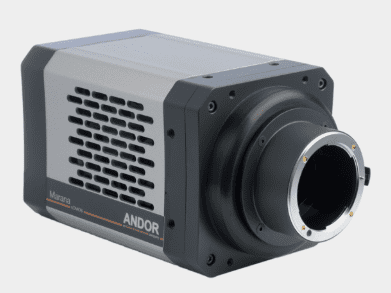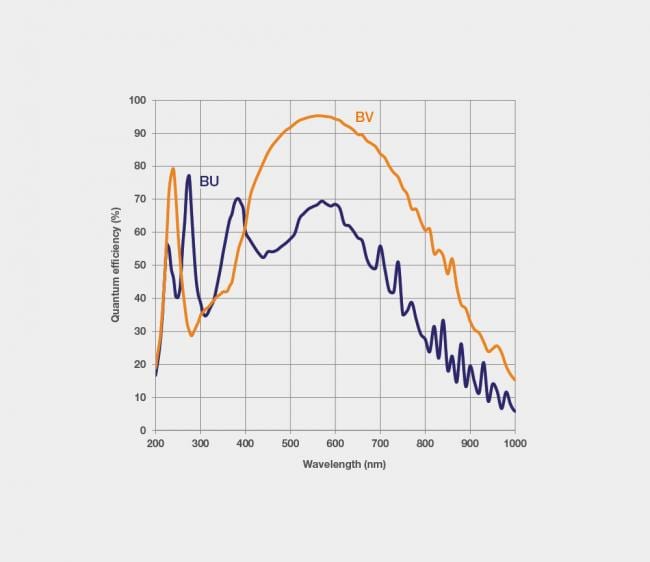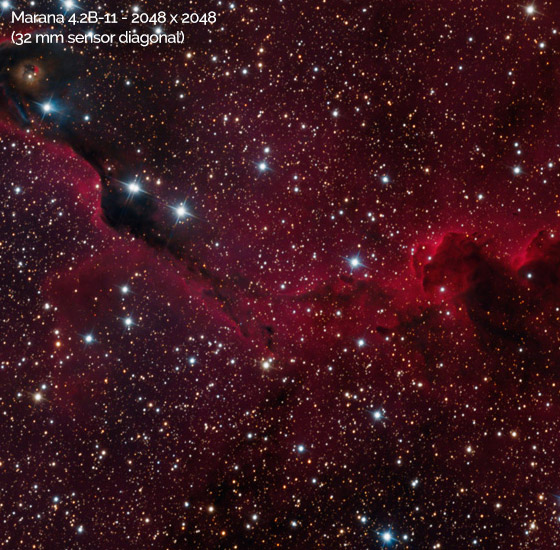

sCMOS Camera for Astronomy and Physical Sciences
Marana is Andor’s latest high performance sCMOS camera platform, ideal for diverse applications within the physical sciences such as astronomy, Bose Einstein Condensation, quantum optics, hyperspectral imaging, neutron tomography and fast spectroscopy. It launches with the large field of view Marana 4.2B-11 back-illuminated sCMOS model, featuring 95% Quantum Efficiency (QE), market-leadingvacuum cooling to -45 °C and 11 µm pixel for optimal photon collection. The large 32 mm diagonal sensor, coupled with rapid frame rate capability, renders the camera ideal for space debris tracking and Near Earth Object (NEO) detection.
Andor’s unique capability to deliver the ultimate in sCMOS sensitivity means signal to noise can be optimized under light starved conditions, ideal for tracking smaller orbital objects, spectroscopic detection of trace concentrations and BEC fluorescence detection of discrete numbers of atoms/ions. Higher sensitivity also means that exposure times can be shortened, facilitating faster frame rate measurements of dynamic processes, complimented by 48 fps frame rate. Marana 4.2B-11 comes with a choice of QE profiles, the UV enhanced option (‘BU’) extending usefulness towards specific application requirements between 260nm and 400nm. The innovative ‘dual-amplifier’ approach to extended dynamic range is ideal for accurately visualizing and quantifying challenging scenes that have both extremely weak and bright regions, such as solar measurements and spectroscopic materials characterisations. Furthermore, to achieve best-in-class quantification accuracy, Andor have implemented enhanced on-head intelligence to deliver market-leading linearity of > 99.7% across the whole dynamic range, ideal for accurate photometry.


Marana 4.2B-11 utilizes a unique Anti-Glow Technology approach that enables one to usefully access the entire 2048 x 2048 array, offering an impressive 32mm sensor diagonal, which in combination with fast frame rates renders the camera ideal for large sky scanning astronomy. It is also ideal for dense multi-fiber hyperspectral applications. The Marana platform can be readily adapted to Adaptive Optics wavefront sensing. Not only is it capable of producing hundreds of fps with ROIs, it is also specifically architected to minimize data transfer lag.
Marana 4.2B-11 comes with F-mount attachment as standard, however for maximum flexibility Andor can also provide an optional C-mount adapter that is readily exchangeable by the user, usable with ROI sizes up to 1400 x 1400 (2 Megapixel). For attachment to various low f/# professional telescope configurations, Andor’s Customer Special Request (CSR) service can provide custom mount faceplates tailored to your specific optical needs.
95% QE & lowest noise – Maximum signal to noise for light starved measurements. Detect smaller orbital debris; BEC fluorescence.
4.2 Megapixel and 32 mm diagonal – Largest field of view sCMOS, compatible with wide range of acquisition times. Large sky scanning; Tomography.
UV-optimized QE option – Enhanced UV sensitivity between 260 – 400nm. Wafer Inspection (266nm)
Vacuum Cooled to -45 °C – Very weak signals require lowest noise floor and longer exposures: Don’t be limited by camera thermal noise!
The ONLY vacuum back-illuminated sCMOS – Andor’s proprietary UltraVac™ technology protects the sensor from moisture and QE degradation over time.
Anti-Glow Technology – Allows access to full array with long exposures – field of view and sensitivity advantages.
48 fps (4.2 Megapixel) – Image highly dynamic scenes without signal smear. Space debris tracking; NEOs.
Extended Dynamic Range mode – ‘One snap quantification’ across a 53,000:1 signal range – perfect for Photometry
> 99.7% linearity – Market leading quantitative accuracy over the whole signal range
Superfast Spectroscopy Mode – On-head vertical pixel binning, ideal for dynamic spectroscopy (up to >24,000 spectra/sec).
Adaptive Optics mode – Minimize lag after data collection – transfer of row data immediately after exposing.
User configurable ROI – Image only what is necessary. Accelerate frame rates and save data storage space.
Fan and Water cooling as standard – Water cooling for maximum sensitivity.
USB 3.0 (also called USB 3.1 Gen 1) – A convenient, universally available high speed interface
| Key Specifications | |
| Sensor Type | GPixel 400 back-illuminated |
| QE Options | BV, BU |
| Active Pixels | 2048 x 2048 |
| Sensor Size | 22.5 mm x 22.5 mm (32 mm diagonal) |
| Pixel Size | 11 μm |
| Pixel readout rate | 200 MHz (12-bit mode) 100 MHz (16-bit mode) |
| Read Noise | 1.6 e- (median) |
| Maximum frame rate | Marana 4.2B-11 – 48 fps (12-bit); 24 fps (16-bit) |
| Maximum Quantum Efficiency | 95% |
| Dark current, e-/pixel/sec at -45°C | 0.2 |
| Readout modes | Rolling Shutter |
| Pixel well depth | 85,000 e- |
| Maximum dynamic range | 53,000:1 |
| Linearity | > 99.7% |
| Photon Response Non-Uniformity (PRNU) | < 0.5% |
| Data range | 12 bit (fastest frame rates) and 16 bit (max dynamic range) |
| Interface | USB 3.0 |